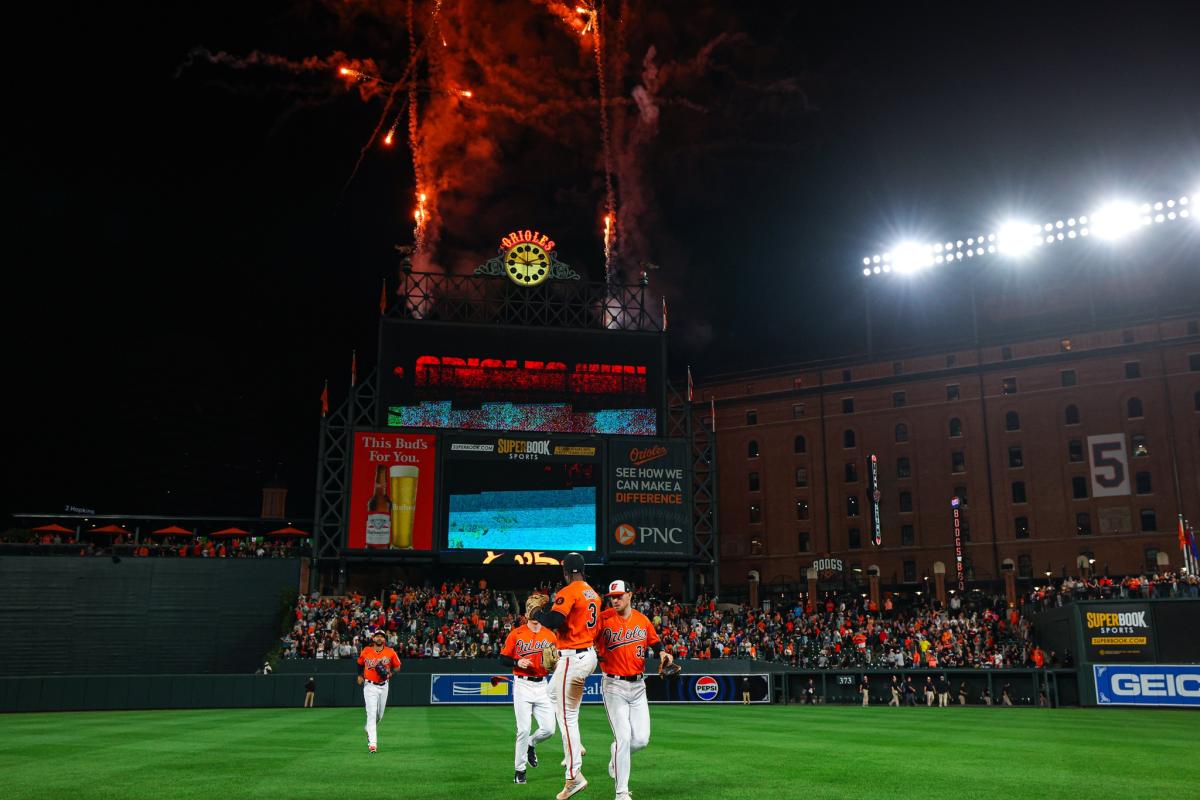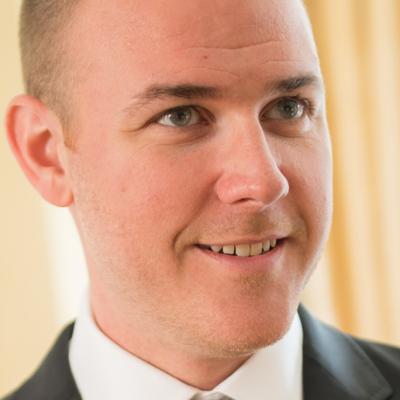
Around 5 o’clock Thursday evening, as the Orioles held their third of four pre-playoff workouts—this one in a mostly empty Camden Yards—first baseman Ryan O’Hearn gripped a bat near the on-deck circle of the home dugout and readied to face a few pitches from left-hander John Means.
Aside from the pop of the catcher’s mitt, the crack of hits, and some occasional cheering around the field, it was eerily quiet in the stadium (much like the pandemic season of 2020). The green seats in all directions were empty and foul balls went unclaimed. Since this was supposed to be preparation for Saturday afternoon’s playoff opener against the Texas Rangers, O’Hearn thought a new soundtrack would be appropriate.
“Can we get some crowd noise on the speaker?” he asked aloud, with catcher Adley Rutschman standing nearby on the top step of the dugout, as if one of the young faces of the franchise had some influence on the music. The practice went on. The crowd noise never came, but everyone’s mind was on the prospect of it coming soon, courtesy of tens of thousands of screaming orange-clad fans.
In the Orioles dugout moments earlier, I asked veteran Gold Glove centerfielder Cedric Mullins what his expectation was for the atmosphere on Saturday at Camden Yards, when the O’s—the top seed in the American League—host the Rangers in the first game of the best-of-five A.L. Division Series. Unprovoked, Mullins brought up the jubilant sea of orange and ear-piercing sounds at Camden Yards during and after Delmon Young’s bases-clearing double down the left field line in the 2014 postseason against the Detroit Tigers. “I’ve seen the video floating around,” Mullins said.
If you were at Camden Yards that afternoon nine years ago, as we were, you may still hear the sounds of that eighth inning and remember the scene. If not, you can imagine. “So loud you can’t hear,” Mullins guessed, based on the YouTube clips he’s watched. He has seen replays for years, including notably when former O’s manager Buck Showalter showed the video of the chills-inducing scene in the team’s film room as a parting gift on his way out of a job late in the 2018 season, when a 23-year-old Mullins was in his second pro year.
In case you need a reminder (or an introduction):
“It’s a highlight that definitely circulates throughout Birdland,” Mullins said Thursday. “It’s a moment that we can look at and understand that this is what we’re playing for. These moments, these crowds, this environment.”
Fellow outfielder Austin Hays concurred, speaking of the play almost like the O’s North Star. “That’s the play you have to watch when you first get drafted, or you sign here,” said Hays, an All-Star this season. “That’s what you play 162 games for—to have a chance to be in your home stadium with your fans behind you in a moment like that.”
The way lifespans in pro baseball go, all of those from the 2014 Orioles that won 96 regular season games (the most until this year) and advanced to the A.L. Championship Series, where the Kansas City Royals promptly swept them, are long gone from the club now. (Although some staffers and ownership, of course, remain.) Same with the O’s team that last made the playoffs in 2016 and exited in a one-game Wild Card round loss in Toronto. (We’re still waiting for Zach Britton to come in from the bullpen.) Only Mullins and fellow 23-year-old outfielder Anthony Santander were around when Showalter showed The Double in 2018, with hopes young players who may stick around in a new leadership regime would understand what’s possible at Camden Yards. Means was also briefly on the team, pitching three innings in one appearance on the mound.
You know how the story continued: In 2019, in came a new front office led by general manager Mike Elias that totally remade the team, from scouting to player development to building an analytics department bigger than one full-timer. Former NASA scientist and O’s assistant GM Sig Mejdal went to work building a team. The minor league system blossomed—boasting this year as many as nine of the top 100 prospects in one publication—and so did major league results, ahead of schedule, under manager Brandon Hyde.
Now, the idea for this version of the Birds—one led by young budding superstars like the 22-year-old rookie Gunnar Henderson and the 25-year-old wunderkind Rutschman; rebuild veterans like Mullins, Means, Santander, Hays, and Ryan Mountcastle; role-playing heroes like O’Hearn, Ramón Urías, or Jorge Mateo; and an emerging top-line starting pitcher in Kyle Bradish—is to create their own signature, stadium-shaking, cathartic playoff moment(s).
Moments that could define playoff baseball, and sports, in Baltimore in another decade, because it’s been seven years—and one heck of an organizational rebuild, from 100-plus loss seasons in 2018, 2019, and 2021 to 101 wins this year—since the Orioles last made the postseason.
“I’m really excited to see the crowd. I’ve heard that playoff baseball here is pretty cool,” Rutschman said on Friday, mentioning a discussion he had with Orioles pitching strategy coach Ryan Klimek, who was in attendance for a postseason game in 2014. “[He] said the atmosphere was absolutely electric. I’m really excited to see the fans and just to feel the excitement.”
It’s also been an even 40 years since the club’s last World Series title, a round-number anniversary that doesn’t seem so outlandish to describe as potentially serendipitous the way these guys play—even if most have never tasted playoff baseball of the major league variety yet. The Orioles, with an average age of 28, bring the third-lowest payroll in pro baseball (roughly $30 million) into the postseason and will face a Texas team that’s spent $180 million more on its roster.
But the Baby Birds and slightly older Mentor Birds have shown their mettle all year, claiming the A.L. East in a year when prognosticators gave the team slim chances of even sniffing the playoffs. They carried one of the best records in baseball all season long and late in the year directly fended off the Tampa Bay Rays to win the division, splitting a series last month in Baltimore that had postseason flavor, even after losing dominant closer Félix Bautista to a season-ending elbow injury.
“For me, we’ve played postseason-type of games these last few weeks,” Hyde said. “It’s hard to hold on to the division lead. It’s hard to lose a couple of games, the first two games of a series against a team that’s trailing you, and win the next two. We showed a ton of character in those kind of postseason-like atmospheres…[We] rallied around each other, stayed together, didn’t drop [our] heads. There wasn’t any sort of negativity about losing those first two. To come back and win the next two showed me a ton about our team.”
As Hays put it: “A lot of people talk about experience, how do we match up? We’re a younger team, lower payroll. There’s only one way to find out.”
That’s to play, in pressure-packed games where every single pitch carries significant meaning. The Rangers just took out Tampa Bay—the O’s expected playoff foil in this round and seemingly biggest challenger—in the A.L. Wild Card round. They never gave the Rays a chance, winning 7-1 and 4-0 in two games, to tax test their suspect bullpen, which the Orioles will look to do. In one-run or extra-inning games this regular season, the O’s went 35-18. The Rangers were 16-25. Interestingly, Texas also has the only player, 39-year-old pitcher Max Scherzer, who was in Camden Yards in 2014 to witness Young’s bases-cleaning double in person. The day before, Scherzer started Game 1 of that series for Detroit. He’s been injured with a bad shoulder since mid-September and may return this series to help out Texas’ pitching staff, because Scherzer’s experience in 22 career postseason starts is invaluable. Throwing or hitting a ball amid a din of noise and relentless pressure is invaluable.
“It’s all about handling emotions and the atmosphere,” said Orioles veteran pitcher Kyle Gibson, one of the few O’s with MLB postseason experience. He’s the oldest on the team at 35, and won a World Series with the Philadelphia Phillies last year. “We’ve got a lot of guys who have played on big stages, maybe not this stage, but mentally they’re ready.”
Rutschman, for example, won a College World Series at Oregon State. Henderson lit up the minor leagues and so far the pros, hitting the deepest home run ever onto Eutaw Street, in one shining example. Gibson said the entire team can draw on their performances in close games this year, as well as the fact they never lost more than four in a row this season.
“We’re one of the teams that does really well after a loss. That has benefited us all year,” Gibson said. “It comes down to how you handle swings in momentum and the crowd, and stress and pressure that’s automatically going to be there. You talk to people who have been there, you feel tired at the end whether you played or not. Even on the bench, you have this pent-up tension, hanging on every moment.”
Fans might feel the same, watching or listening.
“It’s the same when you’re on the field, or even worse,” Gibson said. “You have to be able to handle it. The teams that do that, and players that play well in the clutch or teams that seem like they’re better, they handle the situation with a little bit more calmer heads. And that’s why I’m not too worried about this team…They’ve never done it physically, but mentally you can tell how they handle their business. They’re ready.”
We can’t help but think of something Henderson, a former minor-league top prospect, said after Opening Day this year—that he “blacked out” when getting his first hit against the New York Yankees amid a roaring crowd and stadium full of orange. He went on to struggle with his swing early in the season and sought ways to relieve stress, like playing with Legos. No joke. (I mean, who doesn’t love Legos?) Henderson ended the regular season hitting .255 with 82 RBI and 28 home runs, and was named the team’s MVP.
“I’m just going to go out there and play my game,” Henderson said this week. “I feel like I’ve shown I can play at any level. I’m going to continue to play how I’ve played all year, allow my team to be in a good position to win, and if each and every person does that, we’ll be in a good spot.”
As far as we’re concerned, Henderson has already hit one postseason homer. Sure, it may have been during the practice on Thursday and not in front of any fans, but in the O’s penultimate two-hour tune-up for the postseason, Henderson swung out of left-handed stance with authority. He cracked a major league pitch from teammate and reliever Bryan Baker hard enough that the baseball rattled around the seats and concrete 12 rows deep in the outfield.
Since touching the bases was not necessary, Henderson never left home plate and simply walked back to the dugout satisfied, but if the same result should happen in any of the next few games the Orioles play, you can bet Henderson will soak in the trot around the infield. One might have envisioned the swing would electrify the ballpark in a game, and possibly soon. October baseball is back in Baltimore. The waiting is over.
“This fanbase has been through the last few years of building to something special,” Gibson said. “Hopefully we reward them with good play and I think they’ll reward us with a crowd that’s so much fun to play in front of—which is going create a lot of memories that will be special for a lot of people.”
